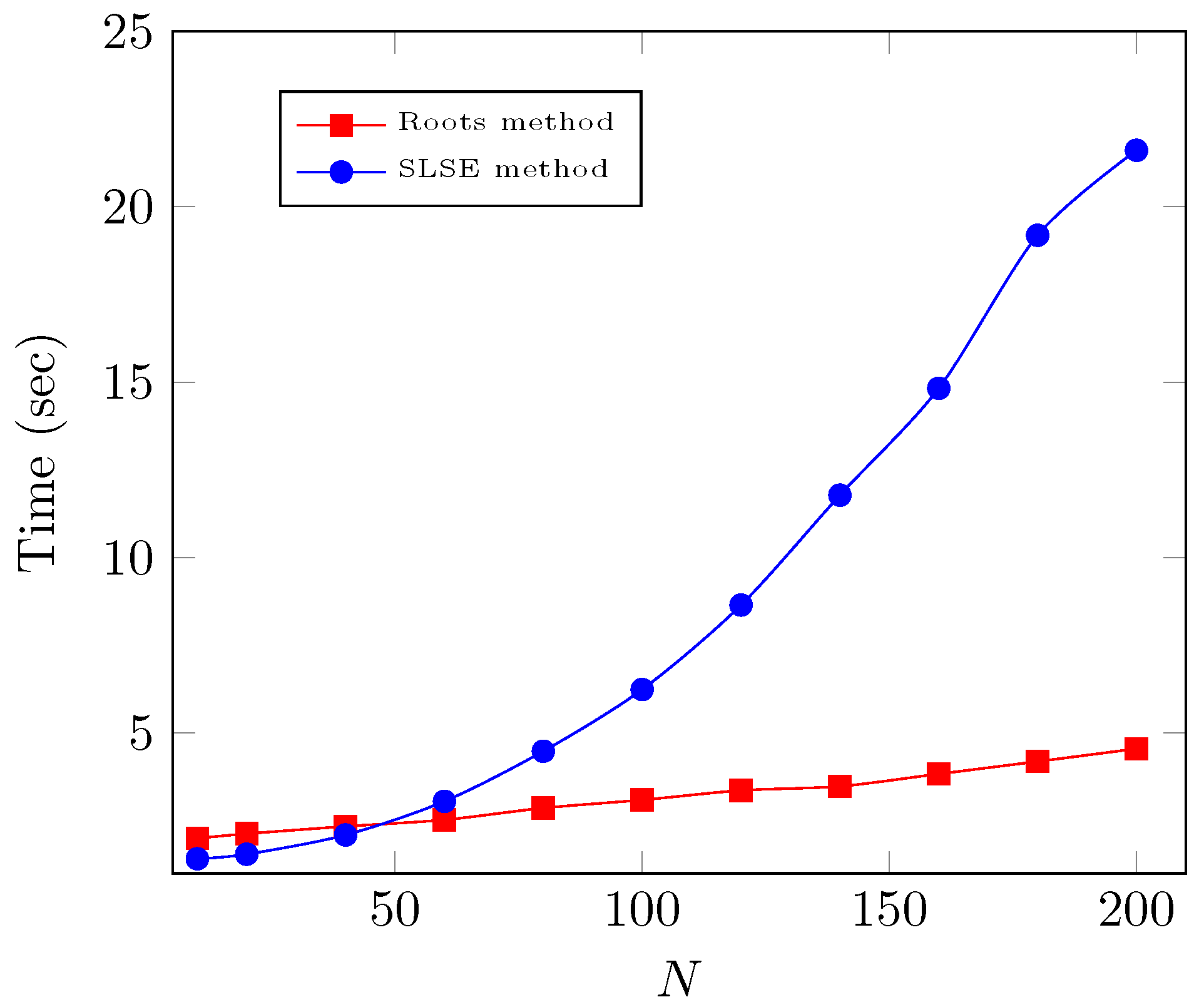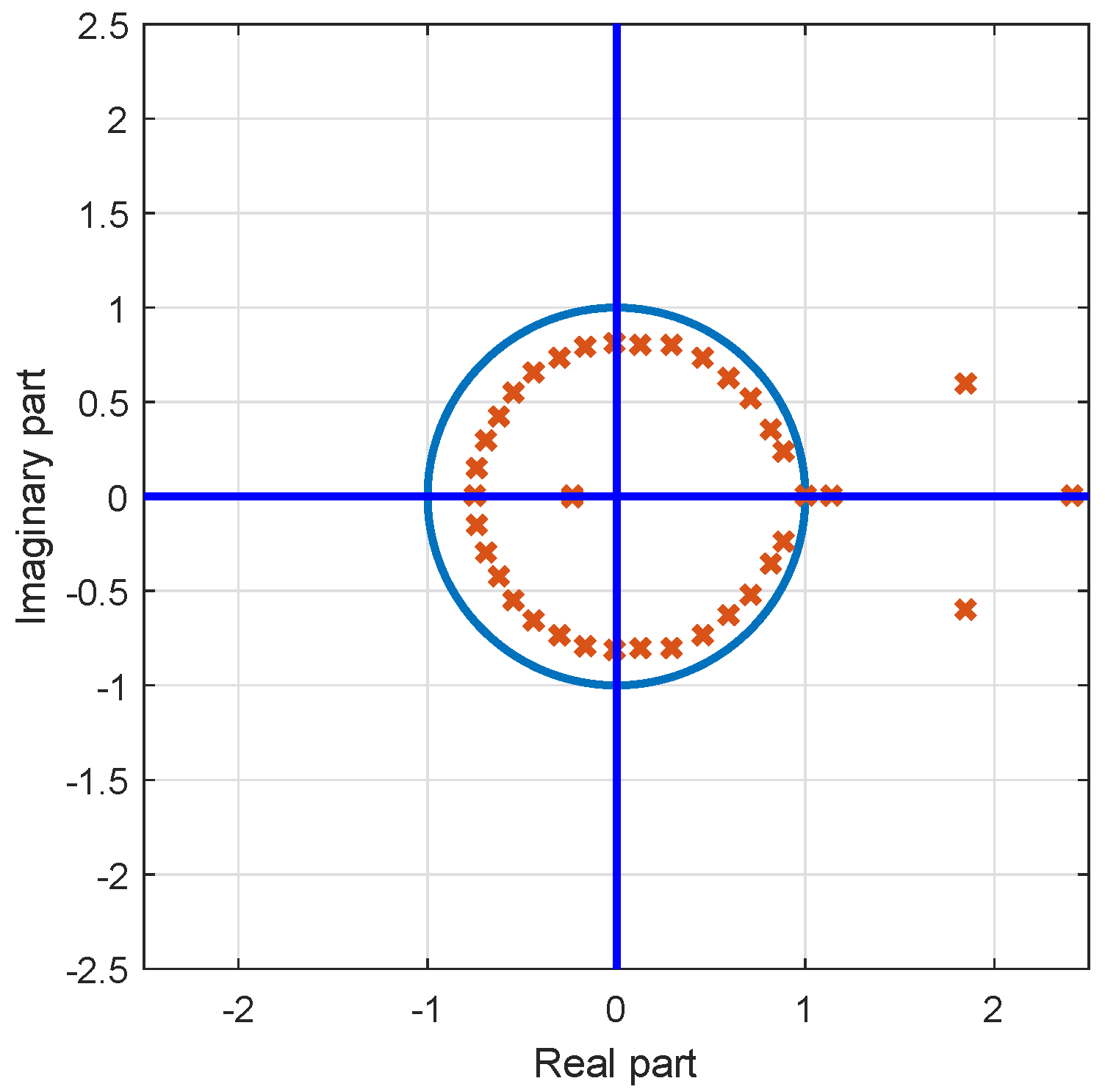The Geo/Ga,Y/1/N Queue Revisited
Abstract
1. Introduction
- We find an alternative method to obtain the steady-state queue-length distributions of at post-departure and random epochs.
- The approach presented in this paper unifies in a way that can handle both the infinite-space as well as finite-space models at the same time.
- We point out the incorrectness of queue-length distributions’ numerical results (at random epochs) reported in Yi et al. [13]. They also assumed batches with a random capacity Y having probability mass function (pmf) instead of .
- We can obtain the continuous-time solution for the model (see Appendix A) and the procedure used here can be applied to obtain a solution for this continuous-time model too. Further, it is anticipated that, using this method, we can obtain waiting-time distribution using Little’s law, a problem for which no solution is available, even using the matrix-analytic method. The primary purpose of this paper is to show its unifying power and superiority over other methods, and to give a simple solution to the existing problem.
- Finally, we compare the roots’ method against the process that uses simultaneous equations and present the results in the numerical section. It clearly shows that the roots approach takes less time.
2. Model Description
3. Queue-Length Distributions
3.1. Post-Departure Epoch Probabilities
- If the s roots remain outside the circle .
- If , among the s roots, one root is , and the other roots are outside the unit circle .
- If , among s roots, one root is inside, say and the other roots are outside, see [26]. One may note that when increases, one positive real root comes closer to the origin from right to left.
3.2. Relationship between the Queue-Length Distributions at Post-Departure and Random Epochs
4. Performance Measures
5. Numerical Results
6. Conclusions
Author Contributions
Funding
Data Availability Statement
Conflicts of Interest
Appendix A. The Continuous-Time Case
References
- Chaudhry, M.L.; Templeton, J.G.C. First Course in Bulk Queues; Wiley: New York, NY, USA, 1983. [Google Scholar]
- Medhi, J. Stochastic Models in Queueing Theory; Elsevier: Amsterdam, The Netherlands, 2002. [Google Scholar]
- Bruneel, H.; Kim, B.G. Discrete-Time Models for Communication Systems Including ATM; Springer Science & Business Media: New York, NY, USA, 2012; Volume 205. [Google Scholar]
- Hunter, J.J. Mathematical Techniques of Applied Probability: Discrete Time Models: Basic Theory; Academic Press: New York, NY, USA, 2014; Volume 1. [Google Scholar]
- Takagi, H. Queueing Analysis: Discrete-Time Systems; North Holland: Amsterdam, The Netherlands, 1993; Volume 3. [Google Scholar]
- Gravey, A.; Hébuterne, G. Simultaneity in discrete-time single server queues with bernoulli inputs. Perform. Eval. 1992, 14, 123–131. [Google Scholar] [CrossRef]
- Chaudhry, M.L.; Chang, S.H. Analysis of the discrete-time bulk-service queue Geo/GY/1/N+ B. Oper. Res. Lett. 2004, 32, 355–363. [Google Scholar] [CrossRef]
- Denteneer, D.; Janssen, A.J.; Van Leeuwaarden, J. Moment inequalities for the discrete-time bulk service queue. Math. Methods Oper. Res. 2005, 61, 85–108. [Google Scholar] [CrossRef]
- Goswami, V.; Mohanty, J.; Samanta, S.K. Discrete-time bulk-service queues with accessible and non-accessible batches. Appl. Math. Comput. 2006, 182, 898–906. [Google Scholar] [CrossRef]
- Gupta, U.C.; Goswami, V. Performance analysis of finite buffer discrete-time queue with bulk service. Comput. Oper. Res. 2002, 29, 1331–1341. [Google Scholar] [CrossRef]
- Janssen, A.J.; VanLeeuwaarden, J. Analytic computation schemes for the discrete-time bulk service queue. Queueing Syst. 2005, 50, 141–163. [Google Scholar] [CrossRef]
- Sivasamy, R.; Pukazhenthi, N. A discrete time bulk service queue with accessible batch: Geo/NB(L,K)/1. Opsearch 2009, 46, 321–334. [Google Scholar] [CrossRef]
- Yi, X.W.; Kim, N.K.; Yoon, B.K.; Chae, K.C. Analysis of the queue-length distribution for the discrete-time batch-service Geo/Ga,Y/1/K queue. Eur. J. Oper. Res. 2007, 181, 787–792. [Google Scholar]
- Banerjee, A.; Gupta, U.; Goswami, V. Analysis of finite-buffer discrete-time batch-service queue with batch-size-dependent service. Comput. Ind. Eng. 2014, 75, 121–128. [Google Scholar]
- Zeng, Y.; Xia, C.H. Optimal bulking threshold of batch service queues. J. Appl. Probab. 2017, 54, 409–423. [Google Scholar]
- Chaudhry, M.L.; Harris, C.M.; Marchal, W.G. Robustness of rootfinding in single-server queueing models. ORSA J. Comput. 1990, 2, 273–286. [Google Scholar] [CrossRef]
- Gouweleeuw, F.N. A General Approach to Computing Loss Probabilities in Finite Buffer Queues. Ph.D. Thesis, Vrije Universiteit Amsterdam, Amsterdam, The Netherlands, 1996. [Google Scholar]
- Powell, W.B. Stochastic Delays in Transportation Terminals: New Results in the Theory and Application of Bulk Queues. Ph.D. Thesis, Massachusetts Institute of Technology, Cambridge, MA, USA, 1981. [Google Scholar]
- Kendall, D.G. Some recent work and further problems in the theory of queues. Theory Probab. Its Appl. 1964, 9, 1–13. [Google Scholar] [CrossRef]
- Kleinrock, L. Theory. In Queueing Systems; Wiley-Interscience: New York, NY, USA, 1975; Volume 1. [Google Scholar]
- Neuts, M.F. Matrix-Geometric Solutions in Stochastic Models: An Algorithmic Approach; Courier Corporation: Washington, DC, USA, 1994. [Google Scholar]
- Stidham, S., Jr. Applied Probability in Operations Research: A Retrospective; University of North Carolina, Department of Operations Research: Chapel Hill, NC, USA, 2001. [Google Scholar]
- Chaudhry, M.L.; Goswami, V. The queue Geo/G/1/N+ 1 revisited. Methodol. Comput. Appl. Probab. 2019, 21, 155–168. [Google Scholar] [CrossRef]
- Botta, R.F.; Harris, C.M.; Marchal, W.G. Characterizations of generalized hyperexponential distribution functions. Stoch. Model. 1987, 3, 115–148. [Google Scholar] [CrossRef]
- Kobayashi, H.; Mark, B.L.; Turin, W. Probability, Random Processes, and Statistical Analysis: Applications to Communications, Signal Processing, Queueing Theory and Mathematical Finance; Cambridge University Press: Cambridge, UK, 2011. [Google Scholar]
- Cohen, J.W. The Single Server Queue; North Holland Publising Company: Amsterdam, The Netherlands, 1982. [Google Scholar]
- Boxma, O.J.; Groenendijk, W.P. Waiting times in discrete-time cyclic-service systems. IEEE Trans. Commun. 1988, 36, 164–170. [Google Scholar] [CrossRef][Green Version]
- Yang, T.; Li, H. On the steady-state queue size distribution of the discrete-time Geo/G/1 queue with repeated customers. Queueing Syst. 1995, 21, 199–215. [Google Scholar] [CrossRef]
- Singh, V. Finite waiting space bulk service system. J. Eng. Math. 1971, 5, 241–248. [Google Scholar] [CrossRef]



| 0.499734 | 0.157755 | 0.030728 | 0.244991 | 0.066960 | 0.010330 | ||
| 0.340335 | 0.290459 | 0.113199 | 0.411838 | 0.190246 | 0.048385 | ||
| 0.118658 | 0.246052 | 0.169892 | 0.239989 | 0.301616 | 0.170317 | ||
| 0.031582 | 0.148137 | 0.161190 | 0.077189 | 0.206250 | 0.172979 | ||
| 0.007532 | 0.079398 | 0.135131 | 0.019965 | 0.116185 | 0.148409 | ||
| 0.001694 | 0.040301 | 0.107666 | 0.004694 | 0.060454 | 0.119818 | ||
| 0.000368 | 0.019932 | 0.084302 | 0.001047 | 0.030223 | 0.093880 | ||
| 0.000078 | 0.009692 | 0.065970 | 0.000226 | 0.014762 | 0.071726 | ||
| 0.000016 | 0.004598 | 0.049310 | 0.000048 | 0.007247 | 0.059329 | ||
| 0.000003 | 0.002109 | 0.033773 | 0.000010 | 0.003379 | 0.041064 | ||
| 0.000001 | 0.001567 | 0.048838 | 0.000002 | 0.001560 | 0.027772 | ||
| 0.000000 | 0.000665 | 0.016418 | |||||
| 0.000000 | 0.000452 | 0.019571 | |||||
| Sum | 1.000000 | 1.000000 | 1.000000 | Sum | 1.000000 | 1.000000 | 1.000000 |
| 0.548733 | 1.095056 | 2.820867 | |||||
| 3.919521 | 3.130145 | 5.137817 | |||||
| 0.000000 | 0.000452 | 0.019571 | |||||
| 0 | 0.170394 | 0.055766 | 0.258523 | 0 | 0.001537 | 0.000432 | 0.009680 |
| 1 | 0.469965 | 0.209576 | 0.111943 | 1 | 0.009682 | 0.00315 | 0.009988 |
| 2 | 0.200698 | 0.27526 | 0.049464 | 2 | 0.010114 | 0.005989 | 0.010254 |
| 3 | 0.088375 | 0.021963 | 3 | 0.010392 | 0.010524 | ||
| 4 | 0.039275 | 0.00974 | 4 | 0.010666 | 0.010801 | ||
| 5 | 0.017414 | 0.004321 | 5 | 0.010946 | 0.011085 | ||
| 10 | 0.000299 | 0.000074 | 10 | 0.012463 | 0.012621 | ||
| 11 | 0.000133 | 0.000032 | 20 | 0.016158 | 0.016363 | ||
| 12 | 0.000059 | 0.000014 | 30 | 0.020947 | 0.021213 | ||
| 13 | 0.000026 | 0.000005 | 40 | 0.027156 | 0.027501 | ||
| 14 | 0.000012 | 0.000001 | 49 | 0.034304 | 0.009883 | ||
| 15 | 0.000005 | 0.000004 | 50 | 0.035206 | 0.049366 | ||
| Sum | 1.000000 | 0.540603 | 0.459397 | Sum | 1.000000 | 0.009570 | 0.990430 |
| = 1.1208, = 1.6012 | = 29.6650, = 7.1493 | ||||||
| = 0.000004 | = 0.049366 | ||||||
| , | |||||||
| 0 | 0.683222 | 0.339297 | 0.15549 | 0 | 0.112580 | 0.052650 | 0.353602 |
| 1 | 0.250531 | 0.463714 | 0.032491 | 1 | 0.313097 | 0.199077 | 0.253667 |
| 2 | 0.051967 | 0.006998 | 2 | 0.337945 | 0.107802 | ||
| 3 | 0.011114 | 0.001551 | 3 | 0.177390 | 0.027021 | ||
| 4 | 0.002447 | 0.000352 | 4 | 0.048246 | 0.004913 | ||
| 5 | 0.000553 | 0.000082 | 5 | 0.008517 | 0.001019 | ||
| 6 | 0.000128 | 0.000019 | 10 | 0.000003 | 0.000003 | ||
| 7 | 0.000030 | 0.000005 | 20 | 0.000000 | 0.000000 | ||
| 8 | 0.000007 | 0.000001 | 30 | 0.000000 | 0.000000 | ||
| 9 | 0.000002 | 0.000000 | 40 | 0.000000 | 0.000000 | ||
| 10 | 0.000001 | 0.000000 | 50 | 0.000000 | 0.000000 | ||
| Sum | 1.000000 | 0.803010 | 0.196990 | Sum | 1.000000 | 0.251727 | 0.748273 |
| = 0.516831, = 3.691651 | = 0.775713, = 1.939284 | ||||||
| = 0.000000 | = 0.000000 | ||||||
| 0 | 0.002177 | 0.000616 | 0.028874 | 0.030809 | 0.011992 | 0.070392 |
| 1 | 0.013258 | 0.004369 | 0.034832 | 0.071536 | 0.039836 | 0.065422 |
| 2 | 0.029345 | 0.036239 | 0.066885 | 0.060557 | ||
| 3 | 0.034741 | 0.035880 | 0.061929 | 0.056044 | ||
| 4 | 0.035937 | 0.034858 | 0.057314 | 0.051866 | ||
| 5 | 0.035505 | 0.033609 | 0.053041 | 0.047999 | ||
| 10 | 0.029400 | 0.027374 | 0.036007 | 0.032584 | ||
| 20 | 0.019366 | 0.018028 | 0.016594 | 0.015016 | ||
| 30 | 0.012753 | 0.011872 | 0.007647 | 0.006920 | ||
| 50 | 0.005531 | 0.005149 | 0.001624 | 0.001470 | ||
| 100 | 0.000685 | 0.000638 | 0.000034 | 0.000031 | ||
| 150 | 0.000085 | 0.000079 | 0.000001 | 0.000001 | ||
| 200 | 0.000011 | 0.000010 | 0.000000 | 0.000000 | ||
| 250 | 0.000001 | 0.000001 | 0.000000 | 0.000000 | ||
| 300 | 0.000000 | 0.000000 | 0.000000 | 0.000000 | ||
| 500 | 0.000000 | 0.000000 | 0.000000 | 0.000000 | ||
| Sum | 1.000000 | 0.004986 | 0.995014 | 1.000000 | 0.051828 | 0.948172 |
| =23.80989, =33.86898 | =11.815062, =20.370796 | |||||
Publisher’s Note: MDPI stays neutral with regard to jurisdictional claims in published maps and institutional affiliations. |
© 2022 by the authors. Licensee MDPI, Basel, Switzerland. This article is an open access article distributed under the terms and conditions of the Creative Commons Attribution (CC BY) license (https://creativecommons.org/licenses/by/4.0/).
Share and Cite
Chaudhry, M.; Goswami, V. The Geo/Ga,Y/1/N Queue Revisited. Mathematics 2022, 10, 3142. https://doi.org/10.3390/math10173142
Chaudhry M, Goswami V. The Geo/Ga,Y/1/N Queue Revisited. Mathematics. 2022; 10(17):3142. https://doi.org/10.3390/math10173142
Chicago/Turabian StyleChaudhry, Mohan, and Veena Goswami. 2022. "The Geo/Ga,Y/1/N Queue Revisited" Mathematics 10, no. 17: 3142. https://doi.org/10.3390/math10173142
APA StyleChaudhry, M., & Goswami, V. (2022). The Geo/Ga,Y/1/N Queue Revisited. Mathematics, 10(17), 3142. https://doi.org/10.3390/math10173142






